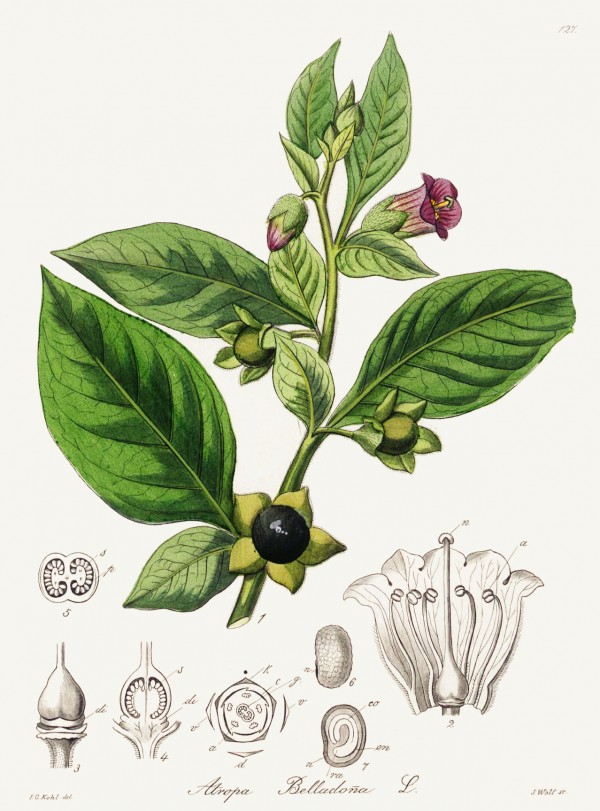Atropa belladonna L. - Solanaceae - deadly nightshade, belladonna, Tollkirsche
Perennial herb, up to 1.50m tall, native to Central and southern Europe, Asia Minor, naturalized in Europe, Northern America, India; leaves alternate, entire, ovate to elliptic, 5-25cm long, up to 12cm wide, margin entire, apex acuminate, pubescent; flowers in the axils with large, leafy bracts, campanulate corolla, purple to brown; berry globose, almost black when ripe.
The (S)-hyoscyamine present in the plant is racemized under the conditions of isolation, giving atropine.
[Zur Kenntnis des L‐Hyoscyamins und Atropins., Schneider, W., Archiv der Pharmazie, 284(5‐6), 1951, 306-318]
Hyoscyamine is the main alkaloid present in all plant parts, accompanied by 6-β-hydroxy hyoscyamine, scopolamine, and 7-β-hydroxy hyoscyamine. „Total alkaloids were two times as high in July as compared to June. In June, the highest alkaloid content was found in the younger part of the stems, here the alkaloids were predominately located in the bark.“ There is also a diurnal rhythm.
[Diurnal and developmental variation of alkaloid accumulation in Atropa belladonna., Sporer, F., Sauerwein, M., Wink, M., Acta Hortic, 331, 1993, 379-386] http://www.uni-heidelberg.de/institute/fak14/ipmb/phazb/pdf-files/1993%20Pdf.Pubwink/12.%201993.pdf
„From the middle of the nineteenth century to the late 1950s, belladonna was incorporated into plasters (and liniments)… These preparations were used in a wide variety of conditions including neuralgia, chronic rheumatism, lumbago, myalgia, pleurisy, pulmonary tuberculosis and acute mastitis. They seemed to have some analgesic and counterirritant effect and were less vicious than those plasters which incorporated the mustard plant. (Brassica juncea or nigra)… Plasters, liniments and eye drops have either become obsolete or have been banned… Susceptibility to the toxic effects of atropine varies widely from individual to individual. Death has occurred after as little as 100 mg and yet instances have been described where the patient has survived even after taking as much as 500 mg. Children are more sensitive to the alkaloid and death has occurred after as little as 10 mg by mouth.“
[Solanaceae IV: Atropa belladonna, deadly nightshade., Lee, M.R., Journal - Royal College of physicians of Edinburgh, 37(1), 2007, 77] http://citeseerx.ist.psu.edu/viewdoc/download?doi=10.1.1.106.7273&rep=rep1&type=pdf

Kohl,F.G., Die officinellen Pflanzen der Pharmacopoea Germanica, t.127 (1891-1895)
http://plantgenera.org/species.php?id_species=118588
Atropa bella-donna © Rolf Marschner (2006) www.botanische-spaziergaenge.at
